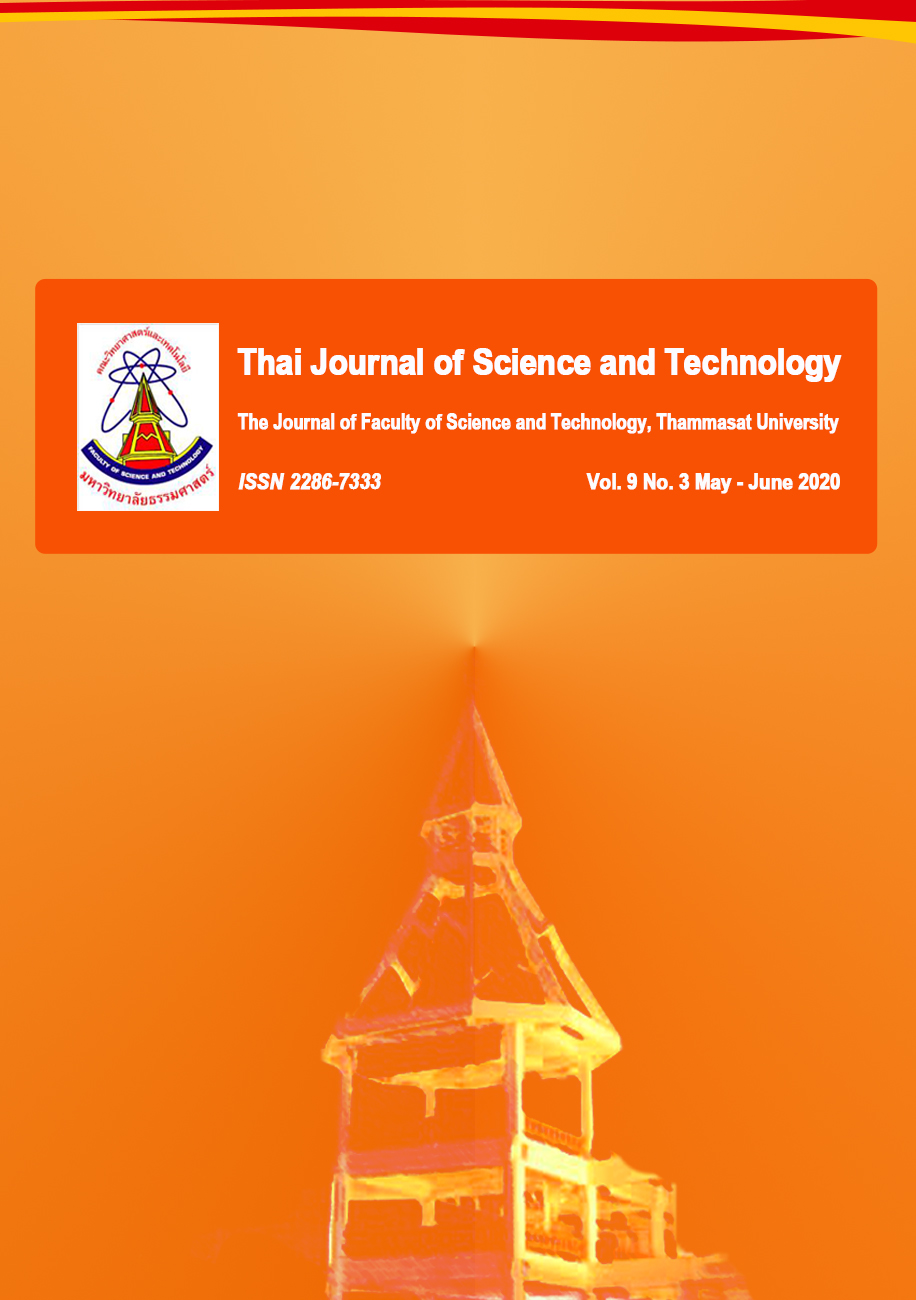ผลของการใช้ที่ดินต่อสมบัติอุทกวิทยาของดินบางประการบริเวณพื้นที่ลุ่มน้ำย่อยห้วยหินดาด จังหวัดระยอง
Main Article Content
Abstract
Different land use types have effects on soil properties, especially soil hydrology. Thus, this research aims were to study and compare some soil hydrological properties in various land uses at Huai Hin Dat subwatershed, Rayong province in 2018. From the results, an average soil porosity was highest in the secondary dry evergreen forest and the lowest in the para rubber area which is opposite to soil bulk density. Soil moisture content was high in the secondary dry evergreen forest at all soil depths and low in forest restoration with teak area. In addition, it was found that soil bulk density and soil moisture content among different land use types and soil depths were highly statistically significant (p < 0.01). For infiltration rates during wet and dry periods, the secondary dry evergreen forest showed the best infiltration capacity with the values between 348-355 mm/hr, while para rubber area was the lowest value with 224-250 mm/hr. And saturated hydraulic conductivity showed the same trend as infiltration capacity. It can be concluded that the types of land use can affect soil hydrological properties differently, which relate to water yield in watershed. Therefore, land use planning and watershed management should be done appropriately.
Article Details
บทความที่ได้รับการตีพิมพ์เป็นลิขสิทธิ์ของคณะวิทยาศาสตร์และเทคโนโลยี มหาวิทยาลัยธรรมศาสตร์ ข้อความที่ปรากฏในแต่ละเรื่องของวารสารเล่มนี้เป็นเพียงความเห็นส่วนตัวของผู้เขียน ไม่มีความเกี่ยวข้องกับคณะวิทยาศาสตร์และเทคโนโลยี หรือคณาจารย์ท่านอื่นในมหาวิทยาลัยธรรมศาสตร์ ผู้เขียนต้องยืนยันว่าความรับผิดชอบต่อทุกข้อความที่นำเสนอไว้ในบทความของตน หากมีข้อผิดพลาดหรือความไม่ถูกต้องใด ๆ
References
นิพนธ์ ตั้งธรรม, 2542, อุทกวิทยาดินลุ่มน้ำ, ภาควิชาอนุรักษวิทยา คณะวนศาสตร์, มหาวิทยาลัยเกษตรศาสตร์, กรุงเทพ.
สถาบันวิจัยยาง, สถิติยางพาราไทย : พื้นที่ปลูกยางพาราในประเทศไทย, แหล่งที่มา: http://www.rubberthai.com/statistic/stat_index.htm, 22 ตุลาคม 2560.
Blacke, G.R. and Hartge, K.H., 1986, Bulk Density, pp. 363-382, In Klute, A. (Ed.), Methods of Soil Analysis, Part 1: Physical and Mineralogical Methods, 2nd Ed., American Society of Agronomy, Madison, WI.
Choi, M. and Jacobs, J.M., 2007, Soil moisture variability of root zone profiles within SMEX02 remote sensing footprints, Adv. Water Resour. 30: 883-896.
Chunlei Z., Jia, X., Zhu, Y. and Shao, M., 2017, Long-term temporal variations of soil water content under different vegetation types in the Loess Plateau, China, Catena 158: 55-62.
Franzluebbers, A.J, 2010, Achieving soil organic carbon sequestration with conservation agricultural systems in the southeastern United States, Soil Sci. Soc. Am. J. 74: 347-357.
Gao, L., Shao, M.A., Peng, X.H. and She, D.L., 2015, Spatial-temporal variability and temporal stability of water contents distributed within soil profiles at a hillslope scale, Catena 132: 29-36.
Gardner, W.H., 1986, Water Content, pp. 1-21, In Klute, A. (Ed.), Method of Soil Analysis Part 1: Physical and Mineralogical Methods, 2nd Ed., American Society of Agronomy, Madison, WI.
Gee, G.W. and Bauder, J.W., 1986, Particle-Size Analysis, pp. 383-411, In Klute, A. (Ed.), Method of Soil Analysis Part 1: Physical and Mineralogical Methods, 2nd Ed., American Society of Agronomy, Madison, WI.
Guoce, X., Zhang, T., Li, Z., Li, P., Cheng, Y. and Cheng, S., 2017, Temporal and spatial characteristics of soil water content in diverse soil layers on land terraces of the Loess Plateau, China, Catena 158: 20-29.
Horton, R.E, 1940, An approach towards physical interpretation of infiltration capacity, J. Soil Sci. Soc. Am. 5: 399-417.
Jury. W.A., Gardner, W.R. and Gardner, W.H., 1991, Soil Physics, 5th Ed., John Willey & Sons, Inc., New York.
Khamyong, S, 2015, Forest Soil: Nature of forest in soil in Thailand, Department of Plant and Soil Sciences, Faculty of Agriculture, Chiangmai University, Chiangmai.
Kusumandari, A. and Nugroho, P., 2015, Land capability analysis based on hydrology and soil characteristics for watershed rehabilitation, Procedia Environ. Sci. 28: 142-147.
Klute, A., 1965, Laboratory Measurement of Hydraulic Conductivity of Saturated Soil, pp. 210-220, In Black, C.A. (Ed.), Methods of Soil Analysis Part 1: Physical and Mineralogical Methods, Agron. No. 9, American Society of Agronomy, Inc., Madison, WI.
Lawler, J., Lewis, J., Nelson, E., Plantinga, A., Polasky, S., Withey, J., Helmers, D., Martinuzzi, S., Pennington, D. and Radeloff, V., 2014, Projected land-use change impacts on ecosystem services in the United States, Proc. Nat. Acad. Sci. USA. 111: 7492-7497.
National Soil Survey Center, 1996, Soil Survey Laboratory Methods Manual, Soil Survey Investigation, Report No.42, Version 3.0, National Resources Conservation Service, United States Department of Agriculture, Washington, D.C.
Sun, D., Yang, H., Guan, D., Yang, M., Wu, J., Yuan, F., Jin, C., Wang, A. and Zhang, Y., 2018, The effects of land use change on soil infiltration capacity in China: A meta-analysis, Sci. Total Environ. 626: 1394-1401.
Thomas, G.W, 1996, Soil pH and Soil Acidity, pp. 475-490, In Sparks, D.L., Page, A.L, Helmke, P.A., Loeppert, R.H., Soltanpour, P.N., Tabatabai, M.A., Johnston, C.T. and Summer, M.E. (Eds.), Method of Soil Analysis Part 3: Chemical Methods, ASA Inc., Madison, WI.
Undawatta, R.P., Anderson, S.H., Gantzer, C.J. and Garrett, H.E., 2008, Influence of prairie restoration on CT-measured soil pore characteristics, J. Environ. Qual. 37: 219-228.
Walkley, A. and Black, I.A., 1947, Chromic acid titration method for determination of soil organic matter, Soil. Sci. Am. Proc. 63: 257.
Witthawatchutikul, P, 1985, Watershed research at Rayong, Thailand, In Proceedings of Seminar on Watershed Research and Management Practices: Towards More Effective Watershed Management, ASEAN-US Watershed Project, College, Laguna, Philippines.


